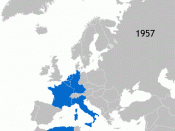The Treaty of Amsterdam (1999) incorporated a range of new polices and transferred areas of justice and home affairs to the community area, but proved unable to reach agreement on it's original objective - that of the institutional reforms required of the EU for enlargement. The EU machinery was designed in the 1950's for 6 member states and has since risen to 15 member states. The prospect of an enlarged EU reaching membership of upwards of 28 states brought about almost unanimous agreement that amendments were needed to the institutions and rules that govern the EU. These changes should ensure the EU develops an infrastructure with the capacity to run efficiently, once enlargement has been achieved. Hence the relatively narrow scope of the Treaty of Nice as it sought to address the deficiencies of the previous Treaty or the so-called "Amsterdam leftovers".
The problems facing the EU before Nice were that both the College of Commissioners and the European Parliament were in fact already too large.
This was of particular relevance to the College of Commissioners, since there are not really sufficient important jobs for the present 20 Commissioners. However it would be fair to believe that any future Member States (pre-Nice agreement) would want their own Commissioner and representatives at the European Parliament. The second key area of discussion and dispute pre-Nice was over the need for an overhauling of the voting system within the Council. This debate centred on two issues; first the current provision for unanimous voting greatly increases the possibility of stalemate on many issues once the EU begins expanding membership. Secondly existing member states (particularly the larger members) became increasingly concerned that under the current conditions for qualified majority voting (QMV) it might see them being frequently outvoted in an expanded EU.


